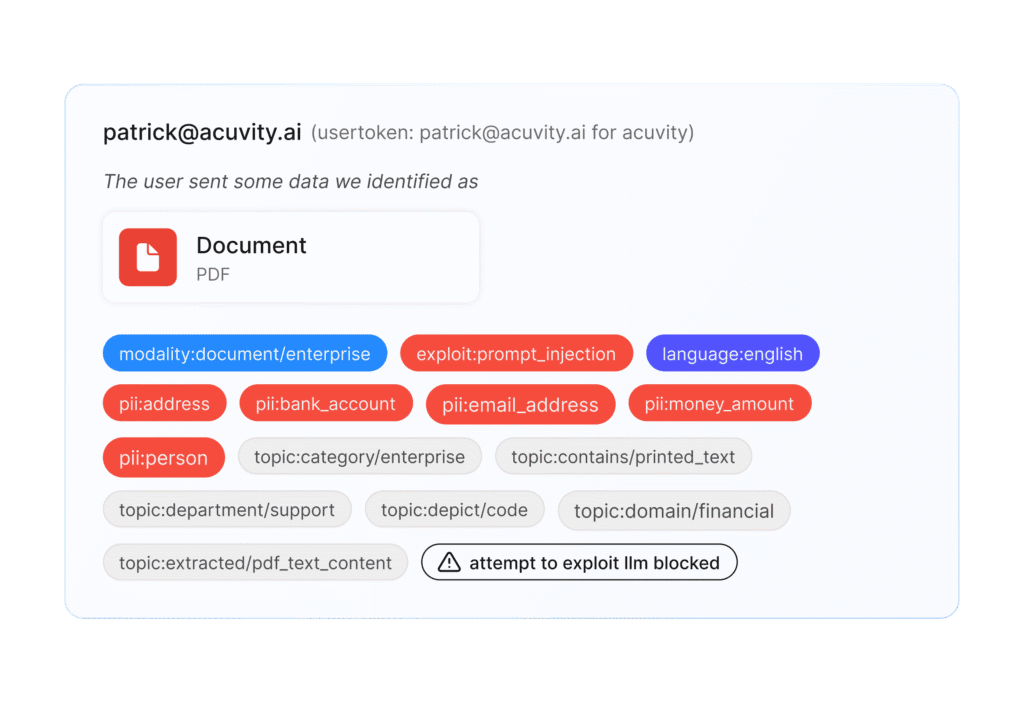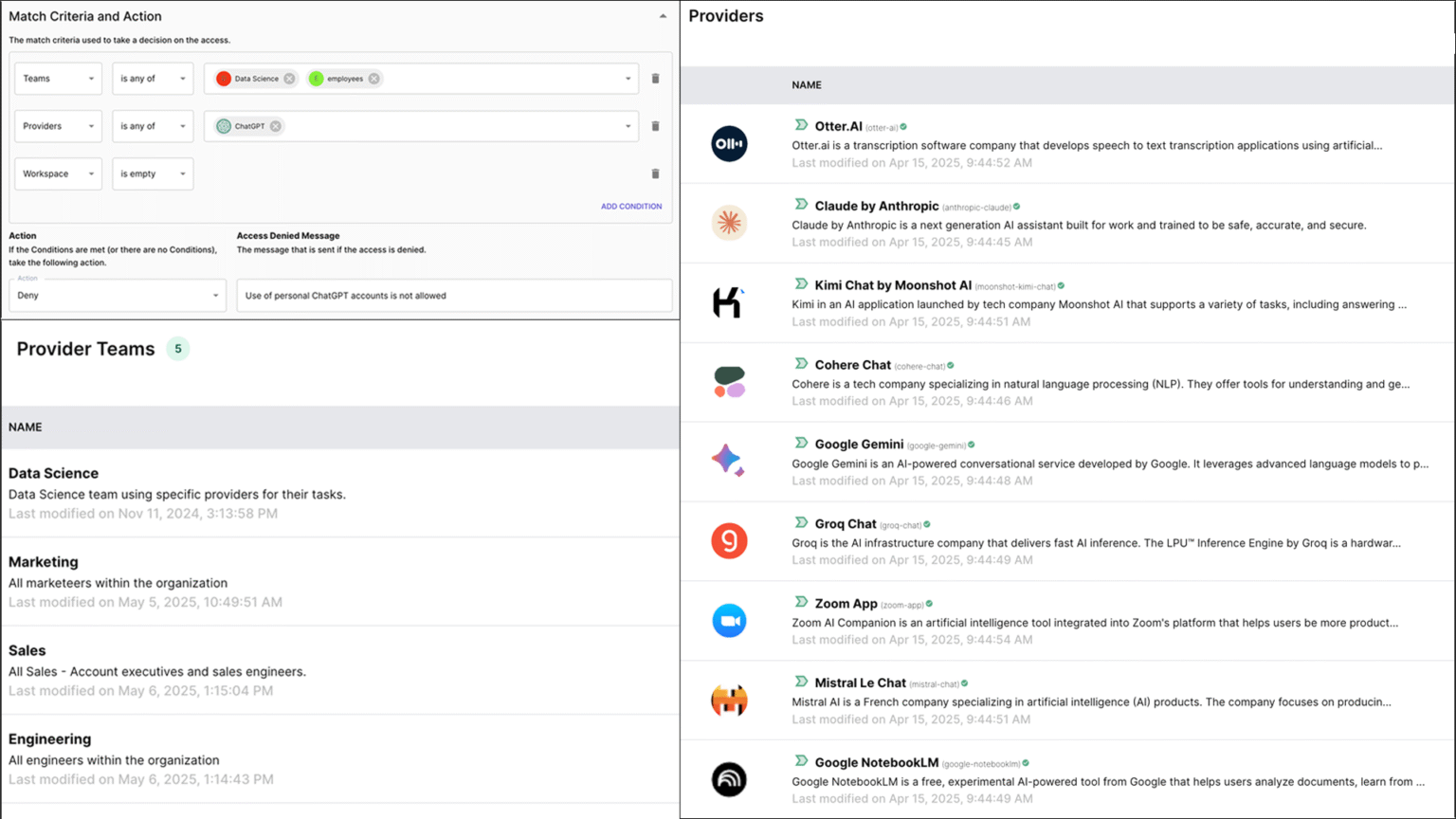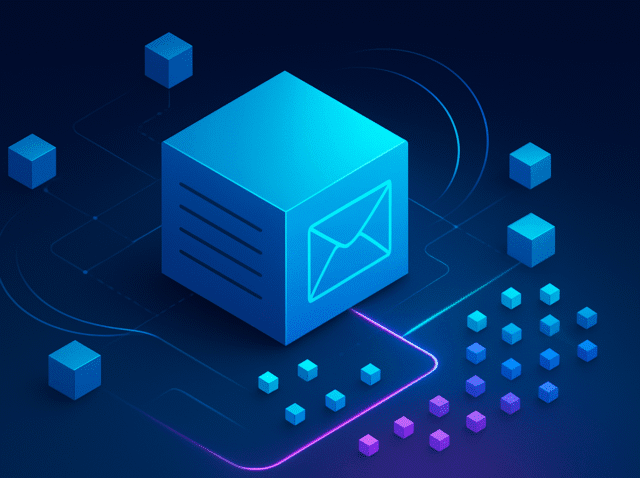Context IQ
Context is Everything.
In the world of Gen AI, context isn’t just important — it’s essential. Every user interaction, agent workflow, data transfer, and external connection creates a complex web of potential risks. Without understanding the full picture — who’s doing what, with which AI models, accessing what data — security gaps are inevitable.

2025 State of
AI Security Report
What the latest data reveals about AI risk, budgets and biggest threats ahead.
Get Your FREE Risk Report
Want to know how risky your AI Services might be? Send us up to five services and we’ll send you back a customized risk report
How It WorksHow ContextIQ Powers Smarter Gen AI Security
Acuvity’s ContextIQ™ engine continuously collects and correlates context across every Gen AI interaction. Here’s how it works:
User and Access Context: Precision Access, Zero Guesswork
In the dynamic world of Gen AI, not all users need access to every tool—and with Acuvity’s ContextIQ™, they don’t get it. The platform starts by understanding exactly who is interacting with Gen AI systems and what they’re authorized to do. This user-and-role intelligence is critical to applying precision-level access across departments.
A marketer using Microsoft 365 Copilot and Beautiful.ai doesn’t need access to GitHub Copilot, just as an engineer doesn’t require Salesforce Einstein to do their job. ContextIQ™ ensures that each team only sees the Gen AI services relevant to their roles—nothing more, nothing less.
This fine-grained control is applied dynamically, powered by flexible policies that can be easily configured via UI, API, or custom policy engines like Rego. The result? Clear boundaries, reduced risk, and zero guesswork.
Identity Context: Trust but Verify
Access control means little without trust in identity. That’s why ContextIQ™ goes beyond surface-level authentication to deeply verify every user and agent interacting with Gen AI systems.
By integrating with enterprise identity providers—like SAML, OIDC, and CIAM platforms such as Descope—Acuvity builds an identity framework where every action is backed by a verified claim. Whether it’s a human user or a Gen AI agent acting on someone’s behalf, the system knows who they are, what roles they hold, and what permissions they carry.
Tokens, roles, and fine-grained attributes fuel dynamic, context-aware policies—ensuring that only the right identities can trigger the right actions at the right time.
Agent and Application Context: Control the Tools, Contain the Risks
Agentic AI systems are powerful, but without context, they’re dangerous. ContextIQ™ brings full visibility into how Gen AI agents operate—what tools they invoke, what data they pull, and which external systems they touch.
Using standards like Anthropic’s Model Context Protocol (MCP), Acuvity maps the entire ecosystem around each agent, from Slack bots and GitHub queries to API calls and database lookups. This insight helps detect subtle forms of misuse—like tool overreach, intent breaking, or privilege escalation—that could go unnoticed in less intelligent systems.
By understanding the environment an agent operates in, ContextIQ™ ensures that every action aligns with your policies, business rules, and ethical boundaries.
Data Context: Know What Flows Where
Every prompt sent to a Gen AI service carries data—but not all data is created equal. ContextIQ™ gives you visibility into every byte moving through Gen AI inputs and outputs, whether it’s a product spec in a spreadsheet, a customer transcript, or a financial model embedded in a PDF.
The platform automatically identifies and classifies sensitive content like PII, PCI, HIPAA-regulated data, and intellectual property. More importantly, it distinguishes between first-party and third-party data, alerting you to potential compliance or privacy violations before they become costly breaches.
In the Gen AI age, data is always moving—and with ContextIQ™, you’ll always know where it’s going.
Threat Context: Stay One Step Ahead
The threats facing Gen AI systems are evolving fast—and most of them hide in plain sight. ContextIQ™ monitors the full lifecycle of every prompt and response, building a contextual thread that reveals emerging threats as they happen.
It’s designed to catch advanced attack patterns—prompt injections, jailbreaks, model poisoning, harmful output generation—before they can do damage. By tracking behavior across sessions and correlating it with user identity, access context, and data sensitivity, ContextIQ™ surfaces the signals that generic tools miss.
With real-time threat visibility rooted in context, your security team is always one step ahead—prepared to detect, respond, and adapt instantly.
join our weekly demoGet the TLDR DEMO:
See How Full Spectrum Visiblity gets Control of Shadow AI

We get it, you’re busy but you want to learn more and you aren’t ready for a full-blown product walkthrough.
No problem, that’s exactly why we hold a weekly, open-house style, live demo from one of our top experts on AI Governance. We’ll cover a lot of topics, but we’ll also reserve time for your specific questions.
In this TLDR Demo you will see:
- Shadow AI
- AI Risk
- Context IQ
- Best Practices
- Enforcement
- Compliance
faqEverything you need
to know about Context
What is Contextual Intelligence (ContextIQ™)?
Contextual Intelligence, or ContextIQ™, is a core component in Acuvity’s Gen AI security suite that captures, analyzes, and secures the contextual metadata surrounding every generative AI interaction in real time. Its purpose is to reveal why an AI event matters—not just what happened—by fusing signals from users, agents, data, applications, and threats into actionable insights.
Here’s how ContextIQ™ functions in depth, what it delivers, and why it matters:
What ContextIQ™ captures
User and access context
It knows who is doing an action—human users or agents—and which roles or permissions they hold. It uses identity systems (e.g. SAML, OIDC, enterprise identity) to map access context.Agent and application context
It monitors AI agents or tools in use, including which external systems, APIs, and data sources they call. It tracks tool invocation scope, chaining, and dependencies (e.g. via MCP).Data context
It inspects the data flowing into and out of AI operations: classifies data (PII, regulated content, IP, etc.), flags sensitive fields, tags which parts of the prompt or response are “high risk.”Threat context
It collects signals of anomalous or malicious behavior (prompt injection, model manipulation, unexpected tool calls) and connects them with the user, data, and application context to flag meaningful risks.Temporal, location, and environmental context
It factors time of operation, network origin, device or IP, concurrency, and other metadata that influence whether a request is “normal” or suspicious.
What ContextIQ™ enables
Prioritized risk insights
With context, the system can rank or prioritize alerts that matter most, reducing noise and focusing attention on genuinely risky events.
Reduced false positives
By understanding surrounding signals (role, data sensitivity, past behavior), ContextIQ™ is better able to distinguish benign activity from risky ones.
Actionable intelligence for enforcement
Because it understands the “why,” enforcement (blocking, redaction, throttling, requiring justification) can be more precise and less blunt.
Intelligent content moderation
It can block or tag harmful content (bias, toxicity, malcontent) in prompts or responses, with awareness of who, where, and how the content is used.
Full context for audit and forensics
In post-incident or compliance review, the chain of context shows who did what, with which model, with which data, and which external systems were involved.
Why ContextIQ™ is Important
Without understanding context, a security system sees isolated events (prompts, API calls) but cannot reliably assess severity or relevance.
Many attacks or misuses are subtle: for example, an agent making queries that are technically allowed but escalating over time. Context reveals the escalation.
Productivity and security trade-off: if enforcement is too blunt (block everything), users will resist. Context-aware enforcement allows flexibility where safe, and firmness where needed.
AI models and tools evolve rapidly. Static rules become obsolete. ContextIQ™, by tying enforcement to multi-dimensional context, adapts better.
From public sources, Acuvity positions ContextIQ™ as a proprietary intelligence layer layered on top of its risk engine, combining signals such as user intent, data classification, application type, and access patterns to derive richer insight.
How does ContextIQ infer intent or detect anomalous behavior?
Inferring intent means estimating the user or agent’s underlying goal behind an AI interaction. Detecting anomalous behavior means flagging deviations from normal or expected patterns. ContextIQ approaches these tasks by layering multiple signals, correlating them, and comparing them to baselines or learned models.
Signals and methods ContextIQ uses
Behavioral baselines
For each user, agent, or application, ContextIQ learns what “normal” behavior looks like (typical prompt types, frequency, data types, tool calls). When actions deviate, that’s a signal.Prompt structure and pattern analysis
The content, form, and steps in a prompt sequence matter. For instance, repeated chained queries that expand data reach, or adding new unfamiliar APIs in the prompt chain, may suggest “intent creep.”Session and temporal context
If someone starts with a benign prompt and escalates to higher risk queries within the same session, the shift is notable. Similarly, requests at odd hours, from unusual geolocations or from new devices are suspect.Correlation across access and data domains
Suppose a user accesses sensitive dashboards or internal systems, then issues AI queries about that data. The correlation indicates stronger intent. If an agent references code repositories, then suddenly calls a database, that cross-domain jump is suspicious.Tool invocation changes
If a plugin (or agent) begins invoking capabilities it never used before (e.g. code execution, database access), ContextIQ flags that as a change in intent.Weighted risk scoring
Each of those signals contributes weight. If enough weights tip toward suspicious, the system escalates the event.
Because ContextIQ sees many dimensions simultaneously, it can distinguish between benign unusual requests and those that merit intervention. It doesn’t rely on static rules alone.
What decisions or enforcement actions can ContextIQ drive?
ContextIQ’s enriched metadata doesn’t itself block or allow actions. Instead it feeds into Acuvity’s risk engine and dynamic policy engine, which then use the context to decide what to do. Below are the kinds of enforcement moves that ContextIQ’s insight supports.
Enforcement options ContextIQ supports
Allow or deny access
Based on context, the system may outright block a request that is too risky for a user or agent. Or it may permit it if the context is acceptable.
Partial redaction or sanitization
When part of the data is risky (e.g. PII, intellectual property), the system may mask or remove those parts before allowing the rest through.
Prompt transformation or rewriting
In some cases, ContextIQ can inform automated rewriting of prompts to reduce risk (e.g. stripping out sensitive identifiers).
Throttling or rate limiting
If an agent or user is making many high-risk calls, the system may slow them down or limit them to preserve control.
Justification prompts / escalation workflows
For borderline actions, the system may require the user to provide a justification or have manager approval before proceeding.
Session isolation, revocation, or reauthentication
If risk becomes too high mid-session, it may require reauthentication or isolate further actions.
Alerting and logging
Every enforcement decision is captured with context and surfaced to security teams, with relevant metadata to triage quickly.
Adaptive policy adjustment
Over time, operations that ContextIQ surfaces can lead the policy engine to adjust thresholds, add new rules, or refine risk weightings.
Because ContextIQ supplies nuance, these enforcement actions can be fine-grained. The system doesn’t have to be all or nothing. For example, low-risk users or contexts may operate freely; higher-risk ones receive more scrutiny or constraints.
How does ContextIQ relate to DLP++ and traditional DLP?
Traditional DLP systems operate on files, documents, network flows, emails—they look for patterns (regex, keywords, known signatures). They often struggle with unstructured prompts, AI model interactions, or multimodal data (images, code, whiteboard photos).
Acuvity’s DLP++ is the enhanced version built for AI environments. ContextIQ enriches DLP++ by supplying the metadata context that DLP++ needs to make better decisions.
Here’s how they interact:
Contextual awareness for content
DLP++ can flag a prompt that includes a social security number. With ContextIQ, the system knows who submitted it, in what session, from which app, and the chain of related AI calls. That context improves decision making.Sensitivity-aware enforcement
DLP++ might detect a sensitive file upload. ContextIQ can decide whether to block or allow using insight about user role or application context.Alert prioritization
Without context, DLP alerts flood security teams. ContextIQ helps filter, rank, and annotate alerts so teams act on the urgent ones first.New modes of content protection
Because ContextIQ supports multimodal context (images, code, etc.), DLP++ can extend protection to these new content types more effectively.Dynamic policy binding
With context, policies can be applied variably: stricter enforcement where risk is higher, lighter touch where safe, rather than one-size-fits-all DLP.
In short, ContextIQ provides necessary metadata and insight so that DLP++ can operate intelligently in AI environments, rather than relying purely on pattern matching.
blogExplore the Acuvity Blog
Want to learn how Acuvity can help your organization Govern and Secure AI at scale? Let’s talk.
© Acuvity 2025. All rights reserved.
Location
111 W Evelyn Ave, Suite 119
Sunnyvale, CA 94086




